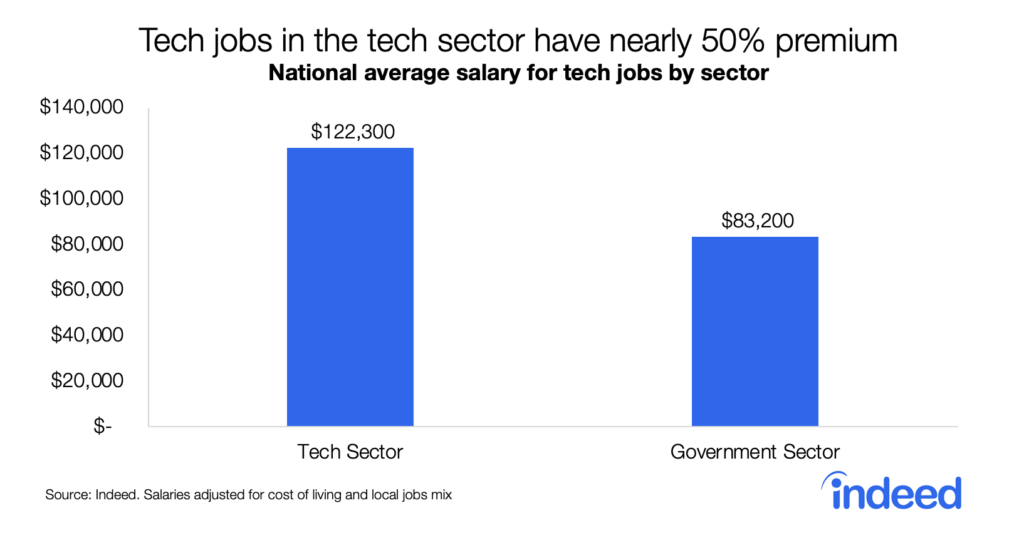Key Points
- Since last year’s government shutdown, federal workers’ interest in the tech sector has continually outpaced that of the general population.
- The government may face a steep challenge attracting tech talent, largely because tech jobs in the tech sector command nearly a 50% salary premium over comparable federal positions.
- Government tech jobs are 7.5 times more likely to require a top-secret security clearance than similar positions in the tech sector—another potential hurdle for job seekers.
This time last year, federal workers endured a 35-day government shutdown, the longest in history. As it dragged on, Indeed found that federal workers looked increasingly for new opportunities. But while the memory of the episode fades, the government faces another challenge — attracting and retaining talent, especially in the ever-expanding tech sector.
Federal agencies looking for tech workers are finding that the private tech sector is a formidable rival. Consider the benefits of a private sector tech job: higher salaries, fewer or no security clearance requirements, tempting perks such as working remotely, and, in a few cases, on-site gyms, dogs at work, and fully stocked snack bars. This may especially be the case for the defense sector now that Amazon’s HQ2 is rising just a stone’s throw from the Pentagon.
To be sure, federal government jobs have their own advantages, such as greater job security and robust pension plans compared with the private sector. Nonetheless, considering the tech sector’s benefits, plus the fact that the federal workforce is aging and the security clearance process can be painfully slow, the question is can Uncle Sam compete?
Shutdown effects linger
The answer appears to be that it’s getting more difficult, according to our analysis of federal worker job searches on Indeed.com. To examine federal worker interest in the private tech sector, we compared the click behavior of federal workers across the country with overall click behavior on Indeed.

Since January 2017, the overall growth of clicks on tech sector jobs has slightly declined, though there was a sharp uptick in October 2018 when Amazon announced its minimum wage increase. In total, in each month of 2019 through November, average year-over-year clicks on tech sector jobs at a group of top-rated and high-profile tech companies declined 7.8 percent compared with the same period two years before.
However, federal workers’ clicks on jobs at these tech companies buck the trend. In each month of 2019 through November, year-over-year federal worker clicks grew on average nearly 11 percent from comparable periods in 2017. What’s more, the trend of rising federal worker interest in the tech sector is nationwide. In the Washington DC metro area, the interests of federal workers and the general public in tech jobs have risen at about the same rate. Outside the nation’s capital though, federal worker interest in tech jobs has grown faster than that of all workers, and that is driving the divergence between federal workers and all workers.
This divergence was particularly apparent during last year’s government shutdown. Federal worker clicks on tech sector jobs rose 14.8% from December 2018 to February 2019. And since then, federal worker clicks on tech sector jobs have grown at rates double digits faster than overall tech sector click growth.
Federal tech worker interest remains elevated
The tech sector consists of many types of jobs — including marketing, finance, and sales positions. Likewise, the occupational mix of federal jobs is diverse, from park rangers and postal workers to CIA agents and statisticians. To untangle the mix, we just looked at the tech sector core — workers in actual tech jobs as identified by their most recent job title, such as software engineer.

We looked at the share of clicks on tech jobs in the private tech sector by federal tech workers compared with tech workers overall since June 2017. As of November 2019, federal tech worker interest in jobs at our group of tech companies was up 6.1% from January 2017, while overall tech worker interest in these jobs fell nearly 21%, a divergence we expect to continue.
Higher pay, fewer clearance requirements likely attracting tech job seekers
So what could be driving federal worker interest in the tech sector? While job seekers weigh multiple factors, such as work culture and location, compensation obviously is key. Controlling for cost of living and job mix across metropolitan statistical areas, tech job postings by our group of tech companies state an average annual salary of $122,300, much higher than the $83,200 average salary in federal government tech job postings. That’s a salary premium of nearly 50% — a steep challenge for the federal government in competing for tech talent.

The tech sector’s advantage doesn’t end there. For instance, many federal national security jobs require a security clearance. And with a top secret security clearance investigation taking over a year, the process can be a significant disincentive to job seekers.

In the 12 months ended in December 2019, 12% of federal tech job postings referred to a top secret clearance, compared with only 1.6% in our tech company group, meaning government tech jobs are 7.5 times more likely to require a clearance. An exodus of cleared workers to the private tech sector could cause worker shortages in high-security government agencies, given the time needed to grant clearances.
Conclusion
Federal worker interest in the tech sector is growing faster than overall interest, particularly since last year’s government shutdown. In particular, federal tech workers are more interested in the tech sector than the average tech worker. This could reflect the fact that tech jobs at a group of top-rated and high-profile tech companies pay on average nearly $40,000 more annually than federal tech jobs. Security clearance requirements also could play a role. Government tech jobs are far more likely to require top-secret security clearances than tech jobs in the tech sector. If cleared workers are leaving federal work, the government may face a shortage of credentialed candidates. For the federal government, attracting and retaining talent appears to be a growing challenge.
Methodology
We looked at the clicks on job postings on Indeed from workers in the federal government. These were identified as Indeed users who uploaded resumes indicating that the federal government was their most recent employer. We then compared the share of clicks by these employees with overall clicks on Indeed job postings. Tech workers were identified by their most recent job title.
The federal government comprises an expansive list of agencies, organizations, and bureaus that are primarily federally funded. The tech sector is identified based on a list of tech companies including the top-rated tech companies from 2019 and 2018 plus additional high-profile tech companies.
The national salary average was calculated by respectively averaging tech salary and government salary for U.S. metropolitan areas with at least 250,000 people. Data are from Indeed job postings from December 2017 to December 2019 that included annual salaries. Salaries have been adjusted based on weighted median deviations across occupations, controlling for different mixes of job titles across metros.
Local cost-of-living data are from the U.S. Bureau of Economic Analysis regional price parities for 2017, released May 2019.
US job descriptions were queried for one or more of these terms: “top secret”, “ts/sci” from December 2018 to December 2019.






